Aquarium Conditioned
Debelius Fairy Wrasse, Male
Cirrhilabrus adornatus,Indonesia
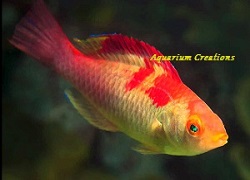
Description:
A very beautiful fairy wrasse collected out of Indonesia, the Debelius Fairy Wrasse is also called the Red Headed Fairy Wrasse or Red Fin Fairy Wrasse. The Debellius as a Juvenile is a lighter color background and as the male matures it will become the beauty seen in the picture. The incredible red and yellow coloration, and beautiful red pallet markings, define it as a true reef tank beauty. With a wonderful personality, it is ideally housed in a well-established reef environment. The male is easily distinguished by the brilliant red blotches in the dorsal region.
The striking resembelance of the male makes it look like a freshwater Koi.
Tank Recommendations:
The Debelius Fairy Wrasse reaches maturity at around 3 inches and the maximum adult size is around 5 inches. We recommend keeping a Debelius Fairy Wrasse in a tank of at least 50 gallons in size. A 2-3 inch sand bed so they can bury themselves in the sand to sleep or hide. Live Rock should be provided for all Fairy and Filament Wrasses. The Live Rock provides numerous small life forms that the Wrasses consider a tasty treat as well as another place to hide when they feel threatened. Note: Wrasses are known to jump from aquariums. Be sure to have some sort of covering with no large open holes that they can escape from.
Food and diet:Best to feed several smaller meals a day rather than one large meal. Best practice is to use a refugium as part of the system’s filtration. This will provide a constant food supply of small live foods (e.g. copepods). A regular diet should include vitamin enriched frozen mysis shrimp, vitamin enriched frozen brine shrimp, and other meaty foods along with a high quality marine flake and marine pellet food.
Reef Compatability: Excellent
Level of care: Easy
Approximate Purchase Size:
2" to 3"
|
Male $69.99
|
Aquarium Conditioned
Exquisite Fairy Wrasse
Cirrhilabrus exquisitus, Terminal Phase Maldives
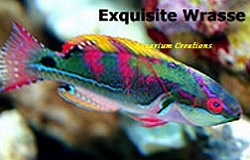
Description:
The Exquisite Wrasse, also called the Emerald Fairy Wrasse, is a gorgeous emerald green with deep maroon to red accents and smatterings of blues, oranges, yellows and purples adorning itself. The coloration is highly variable, and is dependent on numerous factors. The colors will actually change depending on the mood of the fish. Their exact age or maturity, along with their gender and phase dictates the intensity of their coloration and exact markings. Juvenile Exquisite Fairy Wrasse, regardless of their origin, have a white patch on their nose, where the leader of the pack called the Terminal Phase Male will always display the most vibrant coloration when compared to Initial Phase Males, females and juveniles in the group. Occuring over rubble or low patch reefs in areas of current, also on reef edges and around rubble zones. Like other fairy wrasses of the Cirrhilabrus genus, The Exquisite Wrasse once established will become more active and be one of the best eaters in your tank. Given proper care they will give years of enjoyment in either a Reef or Fowler Aquarium.
Tank Recommendations:
The Exquisite Fairy Wrasse maximum adult size is around 5 inches. We recommend keeping in a tank of at least 70 gallons in size. A 2-3 inch sand bed so they can bury themselves in the sand to sleep or hide. Live Rock should be provided for all Fairy and Filament Wrasses. The Live Rock provides numerous small life forms that the Wrasses consider a tasty treat as well as another place to hide when they feel threatened. Note: Wrasses are known to jump from aquariums. Be sure to have some sort of covering with no large open holes that they can escape from.
Food and diet:Best to feed several smaller meals a day rather than one large meal. Best practice is to use a refugium as part of the system’s filtration. This will provide a constant food supply of small live foods (e.g. copepods). A regular diet should include vitamin enriched frozen mysis shrimp, vitamin enriched frozen brine shrimp, and other meaty foods along with a high quality marine flake and marine pellet food.
Reef Compatability: Excellent
Level of care: Easy
Approximate Purchase Size:
Small up to 1.5"; Medium 1-1/2" to 2-1/2" ; Large 2-1/2" to 3-1/2"
|
Small $79.99
Medium $89.99
Large $139.99
|
|
Aquarium Conditioned
Whip Fin Fairy Wrasse
Cirrhilabrus filamentosus,Indian Ocean
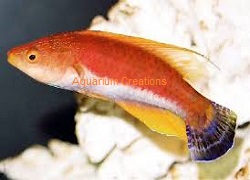 YouTube Video Whip Fin Fairy Wrasse
YouTube Video Whip Fin Fairy Wrasse
Description:
The Whip Fin Fairy Wrasse is an atractive, very peaceful fish that comes from the waters of the Indian Ocean. One of the unforgetable features of the Whip Fin Fairy Wrasse is the super long Dorsal Fin that may be as long as the fish itself. When the Whip Fin Fairy Wrasse displays itself, expect astounding colors including Red, Orange, Yellow , Blue and more! The coloration is highly variable, and is dependent on numerous factors. The colors will actually change depending on the mood of the fish. Their age or maturity, along with their phase dictates the intensity of their coloration and exact markings. If you put in your reef or fowler aquarium a grouping of Whip Fin Wrasse, one will become the Male leader of the Whip Fins and will be called the Terminal Phase Male. He will always display the most vibrant coloration when compared to Initial Phase Males, females and juveniles in the group. The Whip Fin Wrasse is a peaceful, active fish that will bring both color and activity to a fish-only or reef aquarium.
Tank Recommendations:
The maximum adult size is around 3-1/2 inches. We recommend keeping in a tank of at least 50 gallons in size. A 2-3 inch sand bed so they can bury themselves in the sand to sleep or hide. Live Rock should be provided for all Fairy and Filament Wrasses. The Live Rock provides numerous small life forms that the Wrasses consider a tasty treat as well as another place to hide when they feel threatened. Note: Wrasses are known to jump from aquariums. Be sure to have some sort of covering with no large open holes that they can escape from.
Food and diet:Best to feed several smaller meals a day rather than one large meal. Best practice is to use a refugium as part of the system’s filtration. This will provide a constant food supply of small live foods (e.g. copepods). A regular diet should include vitamin enriched frozen mysis shrimp, vitamin enriched frozen brine shrimp, and other meaty foods along with a high quality marine flake and marine pellet food.
Reef Compatability: Excellent
Level of care: Easy
Approximate Purchase Size:
2-1/4" to 3-1/2"
|
|
Aquarium Conditioned
McCoskeri Flasher Wrasse
Paracheilinus mccoskeri (Africa, Sumatra)
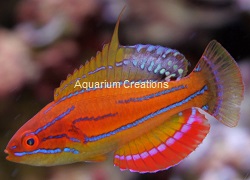 YouTube Video McCosker's Fairy Wrasse
YouTube Video McCosker's Fairy Wrasse
Description:
The McCosker's Flasher Wrasse is an extremely colorful reef-safe wrasse from Sumatra that can definitely be the center of attention in your aquarium. An excellent choice
for the established home aquariums, its colorful body and constant movement make it a smart addition.
Tank Recommendations:
The maximum adult size is around 3 inches. We recommend keeping in a tank of at least 50 gallons in size. A 2-3 inch sand bed so they can bury themselves in the sand to sleep or hide. Live Rock should be provided for all Fairy and Filament Wrasses. The Live Rock provides numerous small life forms that the Wrasses consider a tasty treat as well as another place to hide when they feel threatened. Note: Wrasses are known to jump from aquariums. Be sure to have some sort of covering with no large open holes that they can escape from.
Food and diet:Best to feed several smaller meals a day rather than one large meal. Best practice is to use a refugium as part of the system’s filtration. This will provide a constant food supply of small live foods (e.g. copepods). A regular diet should include vitamin enriched frozen mysis shrimp, vitamin enriched frozen brine shrimp, and other meaty foods along with a high quality marine flake and marine pellet food.
Reef Compatability: Excellent
Level of care: Easy
Approximate Purchase Size:
Small: 1" to 1-3/4" ; Medium: 1-3/4" to 2-1/4" ; Large: 2-1/4" to 3"
|
Small $49.99
Medium $59.99
Large $69.99
|
|
Aquarium Conditioned
Orange Back Fairy Wrasse
Cirrhilabrus aurantidorsalis, Bali Indonesia
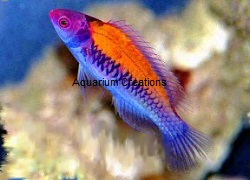 YouTube Video Orange Back Fairy Wrasse
YouTube Video Orange Back Fairy Wrasse
Description:
The orange-back fairy wrasse is closely related to C. solorensis but is not such a familiar species in the aquarium. Males have a crimson head, the back and upper part of the flanks are orange, the belly is bright blue, and a pinkish-red streak runs along the flanks. As males mature, a darker, crown-like mark appears on the top of the head, and scales along the flanks develop dark outlines. If anything, the colors of this species tend to intensify in the aquarium. This is another bold species that spends its time cruising rapidly around the aquarium, generally high in the water column. C. aurantidorsalis is only found in Sulawesi, Indonesia. It grows to around 4 inches and, like C. solorensis, should be kept in a minimum of a 4-foot tank. This species, or at least some individual specimens, will eat red flatworms Convolutriloba retrogemma
Tank Recommendations:
The maximum adult size is around 3-1/2 inches. We recommend keeping in a tank of at least 75 gallons in size. A 2-3 inch sand bed so they can bury themselves in the sand to sleep or hide. Live Rock should be provided for all Fairy and Filament Wrasses. The Live Rock provides numerous small life forms that the Wrasses consider a tasty treat as well as another place to hide when they feel threatened. Note: Wrasses are known to jump from aquariums. Be sure to have some sort of covering with no large open holes that they can escape from.
Food and diet:Best to feed several smaller meals a day rather than one large meal. Best practice is to use a refugium as part of the system’s filtration. This will provide a constant food supply of small live foods (e.g. copepods). A regular diet should include vitamin enriched frozen mysis shrimp, vitamin enriched frozen brine shrimp, and other meaty foods along with a high quality marine flake and marine pellet food.
Reef Compatability: Excellent
Level of Care: Easy
Approximate Purchase Size:
Medium: 2" to 3" ; Large: 3" to 4"
|
|
Aquarium Conditioned
Clown Fairy Wrasse
Cirrhilabrus solorensis (Indian Ocean)
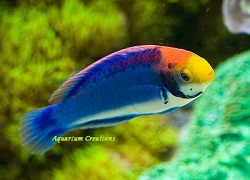 YouTube Video Clown Fairy Wrasse
YouTube Video Clown Fairy Wrasse
Description:
The Clown Fairy Wrasse originates from the west Pacific Ocean through the eastern Indian Ocean, and is primarily found in the waters surrounding Indonesia and Bali. Also called the Solar fairy Wrasse, Tricolor Fairy Wrasse, Red Head Salon Fairy Wrasse, Red Head Wrasse and Solorensis Fairy Wrasse, they are one of the larger Fairy Wrasse reaching a mature size of around 4-1/2 inches. Unlike the coloration of many male fairy wrasse, the Clown Fairy Wrasse keeps their incredible coloration with or without the addition of females. If you are looking for a schooling group of fish for your aquarium, look no further than the Clown Fairy Wrasse. Their truly stunning rainbow of colors, the ease of adjusting to aquarium life, and excellent schooling habits make them a perfect substitute for the much more difficult to keep Anthias. The Clown Fairy Wrasse adapts well to captivity and is easy to care for. They are very colorful, hardy, and friendly towards other fish which make them an ideal saltwater and reef aquarium fish. For those beginners who want to keep their first saltwater aquarium, the Clown Fairy Wrasse is suitable as a beginner fish. Beginner aquarists should not have any trouble caring for this fish.
Tank Recommendations:
We recommend keeping in a tank of at least 75 gallons in size. A 2-3 inch sand bed so they can bury themselves in the sand to sleep or hide. Live Rock should be provided for all Fairy and Filament Wrasses. The Live Rock provides numerous small life forms that the Wrasses consider a tasty treat as well as another place to hide when they feel threatened. Note: Wrasses are known to jump from aquariums. Be sure to have some sort of covering with no large open holes that they can escape from.
Food and diet:Best to feed several smaller meals a day rather than one large meal. Best practice is to use a refugium as part of the system’s filtration. This will provide a constant food supply of small live foods (e.g. copepods). A regular diet should include vitamin enriched frozen mysis shrimp, vitamin enriched frozen brine shrimp, and other meaty foods along with a high quality marine flake and marine pellet food.
Reef Compatability: Excellent
Level of Care: Easy
Approximate Purchase Size:
2-1/2 inches to 4 inches
|
$69.99
|



 YouTube Video Whip Fin Fairy Wrasse
YouTube Video Whip Fin Fairy Wrasse
 YouTube Video McCosker's Fairy Wrasse
YouTube Video McCosker's Fairy Wrasse
 YouTube Video Orange Back Fairy Wrasse
YouTube Video Orange Back Fairy Wrasse
 YouTube Video Clown Fairy Wrasse
YouTube Video Clown Fairy Wrasse